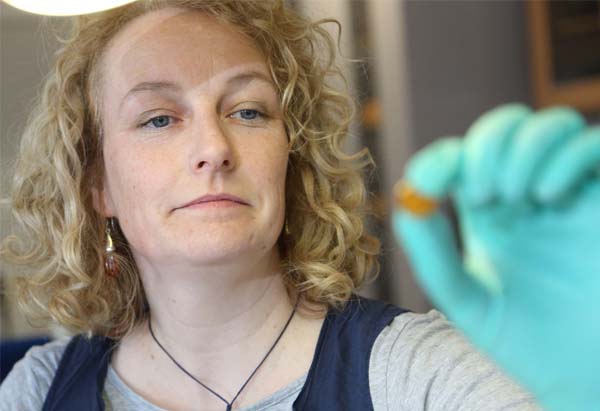A fascination with prehistoric amber and a specialised archaeology degree have led to publishing success for Lisa Moloney, a post graduate researcher at IT Sligo.
The majority of amber beads found in bogland hoards and caves in Ireland date to the Bronze Age (2000-600 BC) and were probably worn or displayed as a mark of high status.
Although they resemble gem stones, they are fossilised resin exuded by trees millions of years ago. Amber beads uncovered in Ireland are thought to have originated in the Baltic Sea region.
Using a scientific technique available to students on IT Sligo’s Applied Archaeology programme, Lisa Moloney has managed to shed fresh light on a long-standing research conundrum — how to determine the geographical area of origin of archaeological amber beads without damaging the artefact.
Her research was supervised by IT Sligo lecturers Dr Marion Dowd and Maria Keeney.
Now Lisa has achieved a major and very early breakthrough as an archaeology science researcher with the publication of her work in “Archaeology Ireland”.
Publication of research findings helps to establish a researcher’s reputation and is vital for professional development and career progress.
Her article is based on her thesis for her BSc (Hons) in Applied Archaeology at IT Sligo in 2011. It is the cover story in the Spring edition of the respected quarterly magazine.
“I am thrilled, especially since the article was based on my final year thesis,” Lisa said. “I hope it bodes well for the prospect of further publications of my current and future research.”
Lisa, who is from Dublin and now lives near Carrick-on-Shannon, Co. Leitrim, was awarded a President’s Bursary at IT Sligo which has enabled her to build on her primary degree by undertaking an MSc Archaeology programme in which she is further developing her research.
She will give a talk on her research to the Sligo Field Club on Friday 26th April at the Education Centre, IT Sligo.
Dr Marion Dowd said: “Lisa’s publication is great news. We hope it will inspire our undergraduates because it underscores the high quality of research being conducted in the Archaeology programme here at IT Sligo.”
The BSc Honours degree in Applied Archaeology at IT Sligo is the only integrated science-based archaeology degree offered in the Republic. It combines archaeological teaching with scientific and technical skills and practical experience.
Lisa says: “I always had an interest in archaeology and the course covers a broad range of topics. It has the scientific side, which includes geology, forensics and scientific analytical techniques, and also covers the theoretical aspects of archaeology. It was the archaeological science elements that particularly attracted me.
“As an undergraduate I could learn and try out analytical techniques on non-archaeological material. As a Masters student, I am able to apply that knowledge to archaeological artefacts. No other archaeology course in the Republic provides this type of detailed learning about scientific analysis.”
Keen to ascertain an efficient testing method that would definitively distinguish between amber from different regions, as an undergraduate Lisa compared three internationally accepted means of analysis, involving Infrared spectroscopy (IR).
Using ATR-FTIR spectroscopy equipment that is available on the Archaeology programme in the School of Science at IT Sligo, she was able to distinguish between amber from the Baltic Sea region and others from Romania and the Dominican Republic. Crucially also, she was able to confirm that it was the only one of the three IR methods that did not cause damage.
She concluded that the ATR-FTIR (Attenuated Total Reflection- Fourier-transform infrared spectroscopy) analysis allows for “non-destructive” analysis to be undertaken.
She said: “Consequently, this indicates that AFT-FTIR is the most appropriate method with which to determine the provenance of archaeological amber samples, as reliable and repeatable results were obtained without the destruction of the sample.”
Photo Caption: Post-graduate researcher Lisa Moloney, who is conducting scientific analysis of amber at IT Sligo.
